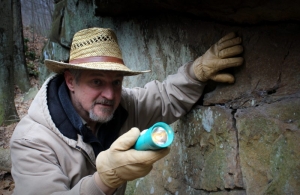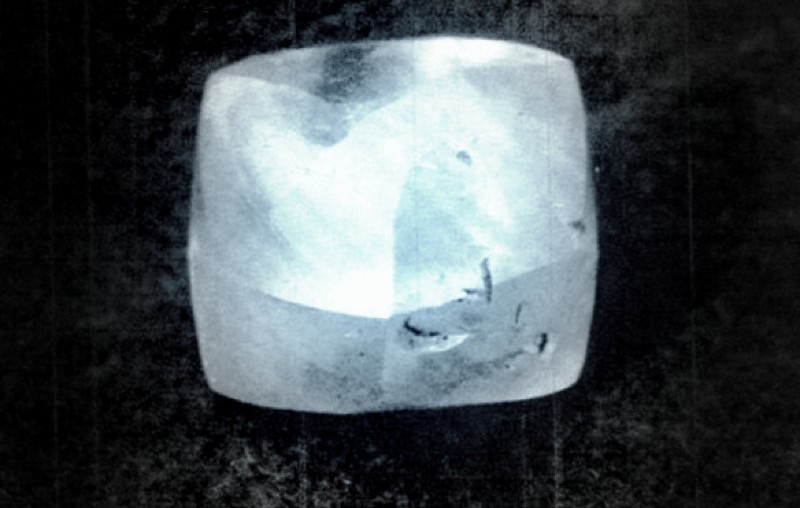PETERSTOWN, W.Va. — Diamonds don't exist naturally in West Virginia, yet one of the largest ever found was discovered in a horseshoe pit in Monroe County in 1928. Geologists are still unable to explain how it got there, and speculation has never died.
The Punch Jones Diamond—also known as the Horseshoe Diamond—remains the largest alluvial diamond ever discovered in North America and the third largest found on the continent.
According to the late historian Shirley Donnelly, the gem was unearthed while Grover C. Jones, Sr., and his son William, better known as "Punch," were pitching horseshoes on a vacant lot along Rich Creek near their home in Peterstown.
"When Punch pitched his horseshoe, it struck a bright object in the hole," Donnelly wrote in a Feb. 23, 1974, column, Yesterday and Today, in The Beckley Post-Herald.
"When dug out, it proved to be a rounded, faceted, glassy mass. It was about three-quarters of an inch in diameter," Donnelly said.
"Although he had expressed the wild notion that he had found a diamond, it was several years before the stone was actually determined to be a diamond."
Punch carried the rock home and stowed it in a box in the tool shed. Fifteen years later, however, he presented it to geology professor Roy J. Holden at Virginia Polytechnic Institute, now Virginia Tech, who examined the stone and declared that it was, in fact, a diamond.
"It is my opinion that this is a diamond," Donnelly quoted Holden as having determined. "It is of good color and appears to be comparatively free from imperfections. It is the largest one ever found in the eastern United States."
The Jones diamond was later exhibited at the Smithsonian, where Donnelly saw it, observing that its hardness was "such that a corner of the crystal readily scratches sapphire and a crystal face of carborundum.
"In the air, the high refractive power of the stone is indicated by the brilliance and the distribution of transmitted light. Under X-rays, it shows an opalescent blue fluorescence."
The bluish-white 34.48-carat diamond measures five-eighths of an inch across and has 12 diamond-shaped faces.
From 1944 to 1968, it was on display at the Smithsonian, after which it was returned to West Virginia and was exhibited intermittently at the State Fair of West Virginia.
The Jones family owned the diamond until the early 1980s when it was auctioned through Sotheby’s of New York. According to a recent uncited account on Wikipedia, the gem was sold to an agent representing a lawyer in an undisclosed East Asian country.
Several theories have been propounded about how the gem could be found in southern West Virginia, far from any diamond-bearing rocks, but perhaps none will ever be proven.
Read also: Little-known facts about West Virginia’s ancient moundbuilders
Donnelly seemed convinced that a bird had transported the diamond. Holden speculated it was washed there from a distant upstream source over millions of years.
"Alluvial diamond" is the term used to describe diamonds that have been removed from the primary source, most often Kimberlite, by erosion over millions of years and deposition in a new environment such as a river bed, an ocean floor, or a shoreline.
It's also possible that someone might have dropped the rock or left it there. Native Americans benefitted from transcontinental trade routes, and archaeologists note that gems have been found in prehistoric burials, though never has the discovery of such a gem as the Punch Jones Diamond has otherwise been documented.
Though some parts of West Virginia contain rich beds of coal, and though coal and diamonds are both of carbon, coal has rarely, if ever, played a role in the formation of diamonds. In fact, most diamonds that have been dated are much older than Earth's first land plants, which are the source material of coal. Here's how diamonds are formed, according to Geology.com
Geologic mystery in Monroe County visible only from the air

Unbeknownst to many residents of the Greenbrier Valley in southern West Virginia, a six-mile crack in the surface earth has been hiding beneath their feet. Visible only from the air, the “Monitor Lineament” is one of the strangest landforms in this scenic landscape of bluegrass pastures, vanishing brooks, and healing springs. Read the full story here.
Sign up to receive a FREE copy of West Virginia Explorer Magazine in your email weekly. Sign me up!



